Social and economic development. Рубрика в журнале - Economic and Social Changes: Facts, Trends, Forecast
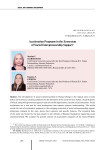
Acceleration programs in the ecosystem of social entrepreneurship support
Статья научная
The development of social entrepreneurship in Russia belongs to the topical areas of state policy and is aimed at creating conditions for the formation of the social services market, the participants of which, along with government agencies and non-profit organizations, become social enterprises. Social accelerators are a new tool for their development that requires systemic understanding. The article reveals the role of acceleration programs in the emerging ecosystem of social entrepreneurship support institutions initiated by the state, shows their common and specific features. The empirical basis of the study was formed by the data posted on the websites of Russian foundations supporting social entrepreneurship. We consider the general scheme of acceleration programs of the Social Projects Support Fund, Social Investment Fund, The Foundation of regional social programs “Our Future” and RAISE University Accelerator (RANEPA), including an analysis of the basic events organized for the participants of accelerators. This article presents systematized data on such interrelated elements of social acceleration as training, mentoring, partner and client networking, local community of social entrepreneurs, direct and indirect funding, and information support. The programs we analyzed followed the same pattern. They include a set of segments, each with a specific function for the development of promising social enterprises. We have identified the problems of exaggerated selection criteria for the acceleration cycle, the lack of direct financing as an element of Russian acceleration programs, which reduces the potential for participation of interested target groups, and weak information support for existing programs. Thus, the results of this study contribute to the study of the strategic advantages and limitations of social acceleration.
Бесплатно
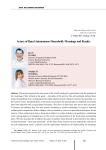
Actors of rural autonomous household: meanings and results
Статья научная
The article examines the main areas of life of self-employed in agriculture from the position of the meanings of life, defined as the goals - principles of life activity. The self-employed include those heads of households who, having passed the initial adjustment and relying on their human potential, use the reserves of new household forms in the local environment, having partially or completely terminated their labor relations with an agricultural enterprise. They have no farm land, they do not have the status of farmers, nevertheless they live and operate according to similar technology. In terms of material wellbeing they surpass their fellow villagers, who are limited to work in an agricultural enterprise. In the context of free employment choice, these actors adhere to certain attitudes and guidelines, conforming (with varying degrees of completeness) to the norms and requirements of the institutions surrounding them. We have described the problems that arise in families whose lifestyle is determined by the objects of their household - plant and animal life. On the basis of our research we have defined the contours of the self-employment actors' creativity and the opportunity limitations of implementing the meanings of household, which is explained by the violation of conjugations in interaction with large agricultural entities, destruction of connections and relations in the production and sale of products. We have found that depending on the changes in a family life, with the transformation of such indicators as age, health, achievement of ultimate goals (for example, the completion of children's education in universities or, on the contrary, their return to the village), the head and family members constantly cross the formal and essential boundaries of the pre-established status, the scale of activity and, in general, the space mastered and not mastered by them. The study of the social experience of autonomous family household contributes to a deeper comprehensive understanding of the deployment of modernization in the village in the context of the conjunction of innovative and traditional trends.
Бесплатно
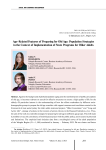
Статья научная
Against the background of global population aging and the transformation of public perceptions of old age, it becomes relevant to search for effective measures to ensure a high quality of life for the elderly. Of particular interest is the understanding of how the efforts undertaken by different socio-demographic groups to prepare for old age correlate with support measures and conditions created in the framework of state social policy for older adults (national projects “Older Generation” and “Long and Active Life”, strategy of actions in the interests of senior citizens in the Russian Federation, etc.). Thus, the aim of the work is to identify strategies for preparing for old age in different age groups. This will make it possible to trace the consistency of individual practices with the public policy, and to assess its potential and limitations. The empirical basis includes data from a sociological survey of the adult population of the Vologda Region (N = 1,500) conducted in January – February 2025. We use cluster and factor analysis methods to study the relationship between value concepts of a prosperous old age and strategies for preparing for it, as well as to establish age-specific features of their perception and formation. We find that good health, financial stability and family ties form the basis of subjective ideas about prosperous old age. Cluster analysis reveals the variability of their combinations, which indicates the absence of a single normative image of prosperous old age. We identify four main components that form strategies for preparing for old age: activity, labor, social, and health. It is proved that each age group chooses its own trajectories to prepare for old age. The revealed imbalances between the ideas of prosperous old age and the practices of achieving it indicate a low level of preparation for old age. The findings of the study provide materials for the development and revision of targeted social policy programs and national projects aimed at improving the quality of life at any age
Бесплатно
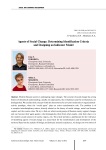
Agents of social change: determining identification criteria and designing an indicator model
Статья научная
Modern Russian society is undergoing major changes. The concept of social change has a long history of theoretical understanding; usually, two approaches, the evolutionary and the revolutionary, are distinguished. We consider this concept within the framework of a new post-modernist or organizational-activity paradigm, when the “social agent” plays an active transformative role. The problem is of a complex interdisciplinary nature, directly related to the theory of social change, social and human capital, and the creative class. We try to find out which social groups of Russian society support changes and can become their agent-guides, what distinguishes them from other people, what their share is in the modern social structure of society, region, city. The article provides a justification for the relevance of identifying agents of social change as a social basis for the transformation and development of the territory. Based on the analysis of foreign and domestic research experience, we design our own notion of For citation: Vorobeva I.N., Mekhova A.A. (2022). Agents of the term “agents of social change”, define the criteria for their identification, create an indicator model for empirical identification of the share of agents of social change in the social structure of the urban community. Theoretical judgments and conclusions are supported by empirical data from a sociological survey of Cherepovets residents. The choice of the city for approbation of the model is not accidental. Cherepovets has the status of a territory of advanced socio-economic development and is in dire need of agents of social change. According to an empirical study, in Cherepovets the core of social change is 4.6%, and the periphery of the core, which we designate as activists, is 17.4%. A comparison of the empirical results of our study and studies of leading Russian authors on the topic of social participation shows that Cherepovets, on average, reflects the general trend in Russia. The population as a whole has rather pronounced attitudes towards activity, while the behavioral practices expressed in our model in various forms of social participation are lagging behind significantly. We prove the validity of the developed model for studying the stated problem and empirically confirm that the development potential of the territory is largely determined by the presence of agents of social change in the social structure.
Бесплатно
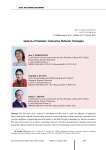
Analysis of students' innovative behavior strategies
Статья научная
The relevance of the research is determined by the need to study the influence of subjective factors and socio-cultural characteristics of actors on the realization of their innovative potential in the current conditions of tightening sanctions policy in the field of high technologies by Western countries. The aim of the study was to find a connection between the types of professional strategies formed by university students and their innovative practices within the framework of university activity. Innovative activity and features of professional strategies are analyzed in a regional context - using the example of three large industrial centers - Yekaterinburg, Tyumen and Volgograd, as well as two metropolitan cities - Moscow and Saint Petersburg. To study the innovative behavior of students, the authors use an activity-based approach, considering innovative activity as a social quality of a subject, implying its internal readiness to master, use, disseminate and create innovations, and highlighting the levels of innovative activity - innovative receptivity and innovative readiness. The conclusions of the article are based on the results of an empirical sociological survey of students of 2-3 undergraduate courses of leading universities of the studied megacities (N=1050), the selection was carried out according to a quota-nest sample). According to the results obtained, a significant part of the regional students is not involved in any types of innovative practices. Students of megacities especially regional are characterized, first, by insufficient innovative activity at the basic level (participation in grant competitions, scientific conferences and seminars, research practices), and second, by a low degree of involvement in scientific and technological creativity and business design. Using the clustering procedure, a typology of students' professional strategies has been developed, five types of strategies have been identified: “professional employment”, “academic career”, “delayed self-determination”, “emigration and uncertainty” and “independent entrepreneurial”. Using correlation analysis methods, it was found that, first, the “academic career” strategy, which promotes active research and inventive practices, and, second, the “independent entrepreneurial” strategy, which correlates with the active implementation of innovative practices in business planning, development of creative and start-up projects, have the greatest innovative potential. “Emigration and uncertainty strategy” is less associated with active innovative activity and is characterized by the lack of formation of professional plans for the near future and intentions to seek work abroad. The “professional employment” strategy, which does not promote active innovative and creative practices, also has low potential. It is pointed out that the dissemination of latest strategies reduces the potential contribution of students to the innovative component of the Russian economy.
Бесплатно
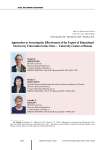
Статья научная
The export of education in Russia was officially proclaimed as a priority area of governmental policy in 2017. The subsequently adopted documents such as the project “Development of the export potential of the Russian education system”, the program “Priority 2030”, and the national project “Science and universities” confirm that the export of education remains an important governmental strategy, despite the changed geopolitical context. The export of education is considered in the works of scientists from Russia and other countries: they study in detail the economics of education export in various countries, adaptation of foreign students, methodological approaches, legal and visa systems of educational migration, etc. The aim of our work is to develop a methodology for evaluating the effectiveness of the export of education by universities in the cities - university centers of Russia and test it on the materials of the Siberian Federal District. Despite a wide range of relevant publications that we arranged in six main groups, these aspects have not been the subject of scientific analysis. We have developed our own system of indicators and indices (a comprehensive indicator of the effectiveness of the export activities of universities in the cities - university centers, calculated on the basis of indices of the educational and research potential of universities’ export activity). The methodology has been tested on the indicators for 115 universities and 30 cities - university centers of the Siberian Federal District. We have revealed that the data are scattered: out of 29 cities where foreign students study, only Tomsk is in the group of cities with high potential for educational and research export activities. The majority of the cities - university centers (22) belong to group 3 - with low potential for educational and research export activities. Our research makes it possible to comprehensively assess the effectiveness of the export of educational services by universities and cities - university centers in each group and set out the priorities for the development of universities; and also identify cities that best meet the needs of the country to implement the export of education.
Бесплатно
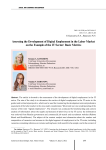
Статья научная
The article is devoted to the assessment of the development of digital employment in the IT sector. The aim of the study is to determine the metrics of digital employment in the IT sector in the gender and territorial perspective, which can be used for monitoring the development and comprehensive assessment of the labor market in the area under consideration. We provide our own understanding of the essence of the term “digital employment”. The research was conducted by benchmarking and content analysis of information about the supply and demand of labor force in the IT sector; the information was retrieved from Russian government and commercial job search and recruitment websites (Rabota Rossii and HeadHunter). The subject of the content analysis was information about the number and composition of vacancies and resumes in the digital segment of employment in the IT sector, including vacancies containing references to remote working hours, both overall in the sample, and in the context of gender and industry. The content analysis covered vacancies and resumes in all federal districts: Central, Northwestern, Southern, North Caucasian, Volga, Ural, Siberian and Far Eastern. The results were used to calculate the structure of professional qualifications, to identify gender specifics and general trends in the development of digital employment in the IT sector, both on average in the country and in the federal districts. The analysis of information on the demands of the labor market participants in the area under consideration allowed us to conclude about the asymmetry of supply and demand. In order to assess the development of the market for professional qualifications in the IT sector, the metrics of digital employment were identified, which help to evaluate its quantitative and qualitative characteristics, including in the gender and territorial perspective. The research results can further be used in monitoring the development and comprehensive assessment of digital employment in the IT sector, and also serve as the basis for the development and implementation of state policy programs to regulate digital employment in the labor market of the IT sector.
Бесплатно
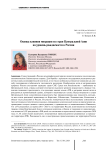
Assessing the impact of migration from Central Asian countries to birth rate in Russia
Статья научная
The current demographic crisis in Russia poses a challenge to the country’s socio-economic well-being. To handle the crisis, the government implements various demographic policy measures; some of them focus on migration as a way to maintain population stability. The largest share in Russia’s migration gain belongs to citizens from CIS countries. Most of them come from Central Asia, whose countries have a high birth rate. These trends suggest that newcomers start families in the Russian Federation, and migration contributes to the birth rate of the host country, which is estimated in the article. The contribution of migration from Central Asian countries to Russia’s birth rate is analyzed as an indicator reflecting the proportion of the number of births by women from Kyrgyzstan, Uzbekistan, Tajikistan, and Kazakhstan in the total number of births in Russia. The empirical base for the research includes three sources of statistical data reflecting an integrated approach to determining migration status: data on place of birth, citizenship and ethnicity. We find that 1.5% of children born in 2011-2023 in Russia are descendants of citizens of Central Asian countries; 0.5% of children born in Russia as of the critical moment of the 2020 census are descendants of Kyrgyz, Uzbeks and Tajiks; 11.1% of children have foreign-born parents (born outside the territory of the Russian Federation). Birth rate in foreign-born persons in Russia is also differentiated by federal districts. Subsequent research on this subject can focus on the dynamics of fertility in mixed families, and include statistics on RF constituent entities.
Бесплатно
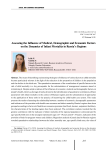
Статья научная
The issues of identifying and assessing the degree of influence of various factors on child mortality become particularly relevant in the light of the reduction in the proportion of children in the population and the decline in the birth rate. The quantitative assessment of the contribution of specific factors to the risk of child mortality is a key prerequisite for the substantiation of management measures aimed at minimizing it. Despite ample evidence of the influence of economic, medical and demographic factors on people’s health, there is a shortage of works devoted to the identification of quantitative correlations of these parameters with infant mortality in the context of Russian regions and the substantiation of approaches to the application of these tools in the practice of improving the child health care system. This study presents the results of assessing the relationship between a number of economic, demographic parameters and indicators of the provision with health care resources and infant mortality. Russia’s regions have been grouped according to the level of health care resources provision (bed fund, doctors, outpatient facilities), the characteristics of the leading regions have been analyzed. The correlation analysis revealed that the greatest correlation with the indicator of infant mortality of the regional population is demonstrated by age-specific birth rates in the youngest reproductive ages (15-19 years and 20-24 years), indicators of the provision of beds for pregnant women and children. Regression analysis of panel data for Russian regions revealed quantitative relationships between the infant mortality rate, age-specific birth rates, the value of gross regional product and the health care resources provision. The results of the study may be of interest to specialists in the field of regional child health care.
Бесплатно
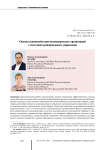
Assessing the interaction between non-profit organizations and the municipal management system
Статья научная
The work brings to the fore the issue of improving the effectiveness of the municipal management system with the help of non-profit organizations’ resource. Our goal is to assess the interaction of nonprofit organizations in the form of territorial public self-government with municipal administration subjects in the municipal management system of the city of Perm. The study hypothesis suggests that the activities of non-profit organizations in the form of territorial public self-government in the municipal management system should produce significant economic and managerial effects, thus increasing the effectiveness of the municipal management system and the municipal economy. Methodologically, the work is based on a synthesis of expert survey methods, factor analysis, and structural equation modeling (SEM). We obtained a number of significant results: we substantiated key scientific categories, defined the basic concept of interaction between non-profit organizations and subjects of municipal government, determined the boundaries of the municipal management system; worked out a methodology for assessing the interaction of non-profit organizations in the municipal management system and tested it on the example of organizations in the form of territorial public self-government in the city of Perm. In particular, we proved that the performance indicators of non-profit organizations in the aggregate of indicators of the use of additional resources and the population are consistently and significantly interconnected with territorial development indicators; interaction with the municipal management system is consistently and significantly interconnected with territorial development indicators; the activities of non-profit organizations are indirectly interconnected with indicators reflecting the development of the territory, due to the processes of interaction with the municipal management system. Thus, we show the presence of direct and indirect effects from the activities of non-profit organizations in the territory, arising in the process of interaction with subjects of municipal government. The presence of such effects substantiates the importance of the activities of non-profit organizations in the form of territorial public administration in addressing issues of local importance, in organizing and implementing local events, in attracting additional funds to solve socio-economic issues of the territory.
Бесплатно
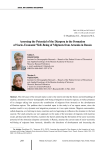
Статья научная
The relevance of the research topic is due to the need to develop the theory and methodology of analysis, assessment of socio-demographic well-being of migration-attractive regions, as well as prospects of its changes taking into account the contribution of migrants from Armenia to the development of Russian regions. The problem that is touched upon in the study is of an urgent nature, since the modern world is very dynamic and migration processes in it are quite intense. Migrant communities, called diasporas, are forming in many countries and are beginning to influence the situation in the host country. The study presents our own approach to the study of the provision of migrants with material, social, spiritual and other benefits, examines the factors promoting the formation of the socio-economic potential of the Armenian diaspora community in Russia, assesses the current state of socio-economic well-being of migrants from Armenia, identifies the directions of development and increasing the efficiency of the use of the socio-economic potential of migrants. Special attention is paid to the analysis of the peculiarities of migration processes in Russia and Armenia as a form of economic activity of communities in foreign cultural spaces. The scientific significance of the study is due to our contribution to the theoretical understanding of the phenomenon of socio-economic well-being of migrants, enriching the theory with empirical data that allows us to define the features and stable trends of the transformation of labor migration, its impact on socio-economic processes in Russia and Armenia. We note that getting into a new social environment and trying to adapt to it, representatives of ethnic groups either occupy free zones in the national economic system, or adopt their own forms of economic activity associated with their ethno-cultural traditions.
Бесплатно
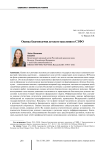
Assessing the well-being of child population in the Northwestern federal district
Статья научная
One of the key challenges for modern states is change in the age structure of the population - a decline in children’s share and an increase in the elderly’s share. In Russia, associated with the declining birth rate, the number of children and their share in the population are also decreasing. This foregrounds the search for manageable factors for preservation of child population’s health and the turn to a comprehensive consideration of the environment that influences it. Children’s well-being is a complex concept reflecting a wide range of issues, ranging from children’s health to the standard of living of their families. Though this issue is of interest, there are only few works devoted to the assessment of children’s well-being in Russian regions. The aim of the study was to assess changes in the child population and characteristics of its well-being in the regions of the Northwestern Federal District. The informational background includes statistical data, results of population surveys, and data of sample observations on socio-demographic issues conducted by the Federal State Statistics Service. It is demonstrated that in spite of the small child population in the regions of the Northwestern Federal District, a steady trend of reducing infant mortality has developed. However, high incidence of disease indicates the continuing risks of loss of children’s health. Based on the analysis of statistical data, it was found that indicators of well-being of the child population in the regions of the District are differentiated. Advantage factors uniting most of the regions under consideration are high provision of children with preventive medical examinations, hot meals in schools, as well as a relatively high degree of their involvement in sports activities. The most pronounced obstacles to achieving children’s well-being in the Northwestern Federal District are the low level of meeting the need for families with children to improve housing conditions, insufficient number of pediatricians, and a high share of families with incomes below the poverty line in some regions.
Бесплатно
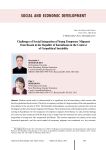
Статья научная
Modern social reality is characterized by a significant level of uncertainty, which creates risks both in a global and local context. This led to a temporary outflow of a large number of the male population from Russia in the autumn of 2022. The Republic of Kazakhstan was among the countries that received the largest number of temporary migrants from Russia. The article presents a brief analysis of the conditions existing in Kazakhstan for the integration of temporary migrants from Russia; we also provide findings of a survey we have conducted with the help of an in-depth interview method; the survey considers social integration of young men who temporarily left Russia. The resource approach was chosen as the main theoretical approach, and the social capital of temporary migrants was considered as a key resource. To address the research tasks, we conducted 20 in-depth interviews with temporary male migrants from Russia who had arrived in Kazakhstan. As a result, we have revealed that social capital plays a significant role in the social integration of temporary migrants. First, the formation of new ties contributes to the formation of a community of migrants from Russia, which is supported by mutual assistance practices. Second, the accumulated social capital in the transnational social space allows temporary migrants to receive assistance from the country of origin, which greatly simplifies the integration process. Third, the social capital formed in the offline and online space is actively transformed from one form to another, which helps to address migrants’ issues in the process of social integration. However, a lack of financial and personal resources in the first place can hinder successful social integration in a new environment.
Бесплатно
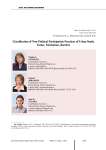
Classification of non-political participation practices of urban youth: forms, motivation, barriers
Статья научная
The article explores civic (non-political) participation practices among young people, which are understood as voluntary, public, and altruistic individual or collective actions. They are viewed as a condition for allowing young people to exercise their right to the city and are aimed at transforming urban space. The role of citizens in modern urban centres is increasing; they are becoming not only users, but also co-authors. Local activities that transform the territory in which young people live lead to an increase in their self-esteem and confidence, the acquisition of soft skills, and the formation of norms of interpersonal interaction. This study's main aim is to identify types of youth civic participation in a large industrial city. Drawing on data from an online survey (quota sampling, n = 800) of young people in the large industrial city of Yekaterinburg (Russia) conducted at the end of 2020, we suggest a typology of civic participation practices. The types were identified through the experience of participation in activities aimed at exercising a right to the city, a willingness to collaborate with other people, the degree of the institutionalisation of civic practices, and motivation to participate or not participate in civic practices. The article argues for building a constructive dialogue with government authorities to meet the needs of young people in transforming urban space. Studying specific do-it-yourself urban design practices in different cities and territories to find the most successful models for potential replication may be a promising direction for further research.
Бесплатно
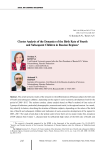
Статья научная
The article presents results of the research in the differentiation of Russian subjects by birth rate of fourth and subsequent children, depending on the region's socio-economic development level for the period of 2005-2017. The authors conduct cluster analysis based on Ward's method of time series of 3 groups of indicators, particularly demographic, economic and social, in the regional context. As a result, they identify 6 clusters, describing the situation of Russian subjects, depending on the values of the birth rate of fourth and subsequent children and indicators of socio-economic development of the region for 2005-2017. The study reveals that in the period under review there are two main trends: first, transition of RF subjects from Cluster 1, characterized by sufficiently high values of the birth rate of fourth and subsequent children and low indicators of socio-economic development, to the clusters with a lower value of the coefficient and higher indicators of socio-economic development; second, transition of RF subjects from the clusters with a low birth rate of fourth and subsequent children to the clusters characterized by the increased birth rate against the background of improved socio-economic development. In the current period, it is possible to distinguish the formation of two poles of large families - these are “the poor with many children” regions, in which a high birth rate of fourth and subsequent children is associated with low socio-economic development, and “the rich with many children” regions with high birth rates and a high level of socio-economic development. Between them there are other RF subjects, which are gradually moving away from the pole of “the poor with many children”, but have not approached the pole of “the rich with many children” yet. The novelty of the study lies in the application of the author's approach to the analysis of relationship between large families and socio-economic development of Russian regions in the temporal dimension.
Бесплатно
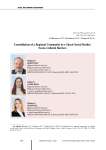
Consolidation of a regional community in a glocal social reality: socio-cultural barriers
Статья научная
The article is devoted to the problem of socio-cultural barriers to the consolidation of a regional community in the context of rising glocalization trends and an increasing role of regions in social development. In our opinion, consolidation in an unstable social reality can only occur as a regulated nonlinear process, oriented toward establishing strong interpersonal and intergroup communication, mutual trust and loyalty. The purpose of the research is to analyze socio-cultural barriers to regional community consolidation, associated with the specifics of value-normative complexes and attitudes of its constituent actors. We assess people’s dispositions concerning the problem of socio-cultural constants renovation on the basis of a sociological research we conducted in the Belgorod Oblast in 2021. It included a mass questionnaire survey (n = 500), an expert interview (n = 30), three focus groups. It is noted that social consolidation can be based on various grounds, but the most solid among them is sociocultural consensus expressed in integration based on common values, social norms, behavior patterns and attitudes - socio-cultural constants that represent a kind of reference points for consolidation process. We analyze components of the value-normative consensus and conclude that its potential as an attractor of the consolidation process can be realized mainly at the microsocial level (primarily family and family-related environment), which significantly restricts the integration opportunities of the regional community. According to the results of sociological diagnostics we reveal the following barriers to the social consolidation of a regional community: fragility of the value-normative consensus, lack of full-fledged regional identity, insufficient focus of authorities and civil society institutions on creating favorable organizational and technological conditions for social conjunction. We emphasize that the implementation of any consolidation strategy at the regional level must necessarily take into account these barriers and provide for measures aimed at their minimization.
Бесплатно
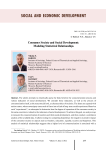
Consumer society and social development: modeling statistical relationships
Статья научная
The article attempts to empirically assess the links between the consumerization process and various indicators of social development. We consider these indicators, as well as the process of consumerization itself, at the macrosocial level, as characteristics of societies. The latter are equated with nation-states, whose sovereignty turns each of them into a kind of long-term social experiment. Based on such “experiments”, we attempted to determine how the degree of expansion of the consumer society in the same countries is related to the indicators of social development. To achieve this goal, we analyze ways to measure the consumerization of societies and their social development, and then conduct a correlation analysis of the available data. It allows testing two competing hypotheses: the negative or positive impact of the consumer society on aspects such as freedom, education, equality, security and happiness. This analysis of statistical relationships suggests that a higher level of consumerization is associated with a higher level of social development, at least on some indicators, such as the level of freedom, gender equality, and subjective well-being. The correlation with these indicators persists even after adjusting for per capita GDP. The presence of statistically significant stable links with social development and the absence of any links with social degradation allows drawing a preliminary conclusion about the refutation of the basic hypothesis of the consumerism criticism and the confirmation of its proponents’ correctness. However, our analysis confirms the connection between consumer society and social development, based on data in a sense formatted by consumer society itself. Therefore, for the final verification of competing hypotheses, it is necessary to develop new, critically oriented quantitative indicators of social development.
Бесплатно
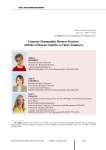
Corporate Demographic Business Practices: Attitudes of Russian Students as Future Employees
Статья научная
The demographic challenges facing the country, especially given their impact on the problem of personnel shortage in the labor market, are creating a demand for the active involvement of business in the implementation of priority national tasks aimed at supporting families and strengthening family values. An institution of corporate citizenship in the demographic sphere is being formed. Enterprises include in the range of social responsibility tasks to support employees fulfilling parental responsibilities and their families. Corporate demographic policy becomes a factor in successful competition for personnel, contributes to the formation of a reputation as a responsible employer. It is relevant and practically significant to study how important corporate demographic practices are for the employees themselves. In terms of forecasting the development of the situation, the opinion of future employees - Russian students - is of particular interest. The article presents an analysis of the ideas of students of Russian universities about corporate demographic practices, about the importance of these practices when choosing an employer. A special perspective and novelty of the study is to identify the relationship between the attitude of students to corporate demographic practices and the expression of their attitudes towards family and parenthood. The author’s methodology for collecting and analyzing qualitative sociological data has been developed and tested. The empirical base consisted of materials from 169 essays by senior students of universities in three federal districts of the Russian Federation - Northwestern, Siberian and Ural. The study revealed a low level of awareness among students about the corporate demographic policy of Russian business. At the same time, the demand for corporate demographic practices depends on the attitudes and value orientations of future employees. Students with high levels of family-oriented attitudes demonstrate higher levels of awareness of corporate demographic practices and give higher ratings to the importance of such practices when choosing an employer. The study confirms the importance of targeted work to develop Russian students’ commitment to family values and ideas about the possibility of effectively combining professional and parental trajectories. A conclusion is made about the potential influence of corporate family support practices on the reproductive behavior of future employees, which in turn contributes to the achievement of strategic national goals to overcome demographic challenges.
Бесплатно
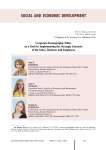
Статья научная
The demographic agenda and transformations of the modern labor market require the concept of corporate social responsibility to be revised, including in the direction of supporting employees who have families. The aim of the study is to develop and test a comprehensive methodology for evaluating existing measures of corporate demographic policy in Russian organizations. Neo-institutional theoretical approach and the theory of employee loyalty served as a methodological basis for the inclusion of the institution of business in the implementation of demographic policy. The empirical study is based on our own methodology for comprehensive assessment ofcorporate demographic policy measures based on three indicators: employee awareness of the existence of measures, usefulness of measures for recipients, and demographic effectiveness. The information base includes materials from a survey of 1,000 respondents living in the Siberian and Ural federal districts. The research produced the following results: 1) the system of measures aimed at supporting Russian workers and their families is not yet extensive, comprehensive and sustainable; 2) we identified measures leading in information promotion, assessment of usefulness and potential impact on reproductive behavior; we also identified measures that are not common in Russian organizations, but have the potential to influence reproductive decision-making; 3) we determined the foundations of a corporate social policy strategy aimed at supporting the state demographic agenda and working out relevant corporate governance practices, focused on taking into account employees’ needs. The findings of the study form an idea of the in-demand vector of strategic planning related to the concept of corporate social responsibility, which, given the transformation of the modern labor market, is aimed simultaneously at supporting the state demographic agenda and strengthening corporate governance.
Бесплатно
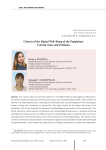
Criteria of the digital well-being of the population: Current state and problems
Статья научная
The current stage of societal development is inevitably linked to rapid digital transformation, the results of which permeate the economy, governance, and virtually all spheres of life. This confirms the relevance of addressing this issue, expanding the information base, and developing tools for assessing the impact of these new conditions on human life. The paper focuses on the digital well-being of the population, with its aim being the development of methodological approaches for its measurement. The article provides a critical analysis of theoretical and methodological approaches to studying well-being and digital well-being, presents an original assessment methodology based on subjective data, and tests it using data from a 2021 representative survey of the population in the Vologda Region. The novelty of the results is confirmed by the proposal of a new assessment approach and the applied results obtained through its implementation, which expand the regional picture of digital development and allow for comparisons and typologization of regions based on the level of the population's digital well-being. The characteristics of the population's digital well-being in the region are analyzed across types of settlements, levels of education and income, and by gender and age characteristics. Many conclusions regarding the persistence of digital divides and obstacles to achieving well-being in the digital environment are confirmed, and the most vulnerable socio-demographic groups are identified. A significant influence of place of residence and age on digital well-being parameters is shown; other factors are less pronounced and require deeper study. The findings concerning society's acceptance of potential digital risks require separate discussion and research. The practical significance of the results is determined by their potential use for managerial purposes, including the strategic planning for achieving national and regional development goals, and the classification and typology of regions based on digital development characteristics. Furthermore, the availability of information on the population's digital well-being can contribute to enhancing the investment attractiveness of the region's IT sector, developing digital education, introducing high-tech goods and services to the market, and other areas of digital transformation
Бесплатно

